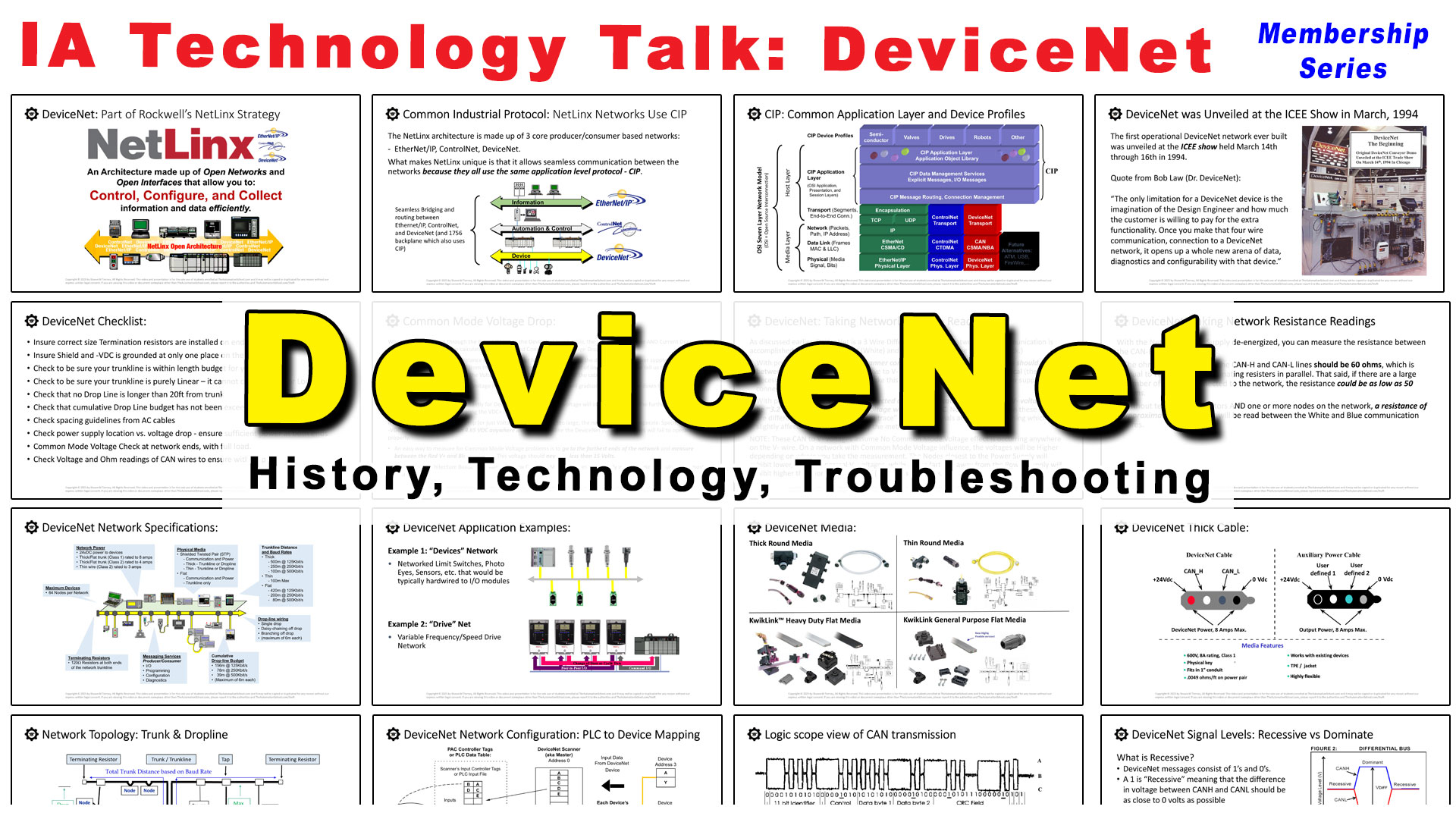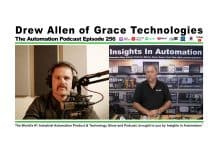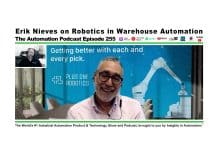
In today’s article and video I’m going to answer the question, “What is DeviceNet?”
If after reading this article you’d like to learn more, you can pickup a copy of my seventy five minute video lecture at TheAutomationSchool.com for just $10, or join my membership program starting at $5/mo to unlock hundreds of member only videos. That said let’s jump in and take a quick look at what is DeviceNet:
Quick Look Video: What is DeviceNet?
For links to the documents mentioned in this video, see the “Show Notes” section located below (Episode TAM QL 007.)
What is DeviceNet?
DeviceNet is an industrial automation network designed for low level devices that was created by Rockwell and its partners and first shown to the public in 1994, and later released in 1995. DeviceNet was also part of Rockwell’s NetLinx network strategy, which included ControlNet and Ethernet/IP, with all three networks being based on the Common Industrial Protocol (CIP.)
Now having been in the industry for a few years when DeviceNet launched, I can tell you there are a lot of advantages to using DeviceNet to network lower level devices (please, no hate mail!) But to be completely honest, there’s also some things about DeviceNet the people just didn’t like.
And while it’s not likely you’ll deploy new DeviceNet networks in 2025, I see no reason that would justify replacing a running system in the field unless you can’t get parts for the products you have connected to your network.
In fact, in 2025 you’re more likely to be using systems based on Ethernet for your distributed I/O, with some of you mixing in IOLink as needed. However deploying Ethernet in industrial automation does have its downsides, including the cost and its limited topologies. When compared to legacy networks like Remote I/O (RIO) and Modbus (which allow simple daisy chained configurations,) the fact that Ethernet requires the installation of an industrial network switch every 100 meters does make it a more expensive solution. That’s not to say their aren’t benefits to using Ethernet, but we’ll leave those for another day.
So back to DeviceNet; the first thing I want to share about it is that it was designed to allow the networking of low level devices like sensors and switches, in order to eliminate the need to wire these devices into IO modules. And this was accomplished by basing DeviceNet on “CAN bus,” which was designed to do the same thing for automobiles (reduce wiring by networking I/O in vehicles.)
The second thing I wanted to share about DeviceNet is that it’s designed around a single Trunkline with optional droplines. And no matter where you connect your devices, or the cable and data rate you choose, the third thing you should know is that the DeviceNet network always supports 64 nodes (0 through 63, although 63 is typically reserved for new devices that default to 63.)
Fourth on my list of DeviceNet details is something that makes DeviceNet wiring quite different from the RIO legacy network. With DeviceNet, not only can you use standard terminal blocks for your T connections (good bye big, bulky 1770-SC station connectors!) you also have a lot of freedom in how you wire your drops. This includes daisy chaining multiple devices on a single drop, as well as wiring a device on a drop in a star configuration.
Really, the only limit (I can think of) when wiring drops is that no device can be more than 20 feet from the trunkline. That, and the total length of all your drop lines has to be within an overall dropline budget (and before you ask, no: you can’t have 64 devices all sitting on their own 20ft drops.)
In my fifth point I want to point out another way that DeviceNet also differs from legacy networks, and that would be because DeviceNet cable includes two power wires (in addition to two communication wires,) and every device on the network consumes a minimum of 60ma from the network power (the minimum power draw required for the CAN transceiver in each network device.)
And while devices with large power draws (VFDs, etc.,) obviously can’t be completely powered from network power, lower power devices like Sensors and Digital Input modules can and often do receive all of their power from the network.
That said, my sixth point acknowledges that no wire has an unlimited power capacity or zero resistance. Due to this fact, where you place your network power supply on your DeviceNet network trunkline is a very important consideration, and must be calculated based on how many devices you have, what each’s power draw is, and where they are located on the network.
DeviceNet does have at lease one similarity with legacy twisted pair networks, which is my seventh point: All DeviceNet networks require two Terminating Resistors to be installed, one on each physical end of the trunkline.
And when I say required, I mean on both short and long trunklines. While those of you who’ve used Blue Hose may have come to know you could get away without terminating resistors on shorter runs, in my own thirty years using DeviceNet I‘ve found that’s not the case with this network.
Now if you’d like to learn more about DeviceNet, you can pickup a copy of my seventy five minute video lecture at TheAutomationSchool.com for just $10, or join my membership program starting at $5/mo to unlock hundreds of member only videos.
And if you’d like to see me publish a quick start video on DeviceNet, just post a comment below letting me know which PLC/PAC system you’d like that video based on (ControlLogix, CompactLogix, etc.)
Until next time, Peace!
Member’s only DeviceNet Tech Talk:
Note: The below seventy-five minute tech talk is just one of hundreds of Shawn’s videos available as part of his membership program, and it is also available for a one time purchase at TheAutomationSchool.com.
Note: As this IA Tech Talk is a member/supporter only perk, the above video is not accessible to non-members. Learn more about our membership options here.
Show Notes: Below you’ll find links to the Rockwell Publications mentioned in the above video:
-
Logix DeviceNet Network Configuration
-
DeviceNet System Quick Reference
-
DeviceNet Media Guide
-
Getting Results with RSNetWorx for DeviceNet
-
DeviceNet Book Of Knowledge link
For more information about the benefits of being a member, check out this link.
Until next time, Peace ✌️
If you enjoyed this content, please give it a Like, and consider Sharing a link to it as that is the best way for us to grow our audience, which in turn allows us to produce more content 🙂
Shawn M Tierney
Technology Enthusiast & Content Creator
Support our work and gain access to hundreds members only articles and videos by becoming a member at The Automation Blog or on YouTube. You’ll also find all of my affordable PLC, HMI, and SCADA courses at TheAutomationSchool.com.
- FactoryTalk Design Workbench First Look, CCW Comparison - December 19, 2025
- Drew Allen of Grace Technologies on Automation, Safety, and More (P256) - December 17, 2025
- Robotics in Warehouse Automation with Erik Nieves of Plus One Robotics (P255) - December 10, 2025

Discover more from The Automation Blog
Subscribe to get the latest posts sent to your email.





